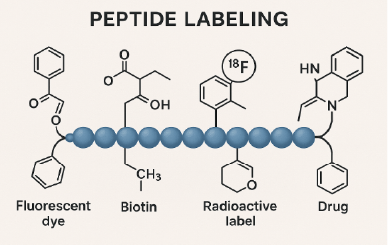Site-Specific Labeling High Labeling Efficiency Wide Label Options
The peptide labeling belongs to a kind of peptide modification synthesis, and the addition of an appropriate label in the peptide molecule is helpful for the study of the peptide. Creative Peptides has vast experience in designing and producing labeled peptides and provides all common peptide labeling services. Our experienced technicians will ensure that the most suitable methods and techniques are selected for each peptide project.

Peptide labeling is a technique employed to attach a chemical or a fluorophore to a peptide sequence, thereby imparting specific properties or enabling visualization under various analytical techniques. This process facilitates the study of peptide interactions, localization within cells or tissues, and elucidation of molecular pathways. By selectively modifying peptides with labels, researchers can track their behavior, monitor changes, and gain insights into biological phenomena with unparalleled precision.
Peptide labeling enhances detection of target peptides in complex biological mixtures such as serum or cellular extracts.
By labeling peptides with colored or fluorescent dyes, they can be easily separated from non-labeled components of a mixture, thus simplifying analytical processes such as chromatography.
In biological imaging, labeled peptides can be used as specific markers for cells, tissues, and organs. This is helpful in studying biological processes and diseases.
Some labels can improve the stability of peptides in different environments, making them more suitable for various experimental conditions.
Peptide labeling can allow for the tracking of peptides and proteins within a cellular context, providing insights into protein-protein interaction or the movement and localization of proteins within a cell.
Peptide labeling can increase the specificity of binding to target molecules, improving the accuracy of experimental results.
Stable isotope labeled peptides
Isotopic labeling refers to the replacement of atoms with different heavy isotopes. A common alternative is 12C by 13C, of 14N by 15N, and of 1H by 2H (deuterium). Creative Peptides can provide customized peptides labeled with stable isotopes including 2H, 15N & 13C, respectively, or a combination of 15N & 13C. Even when the peptides are attached with specific modification motifs.

Studies of peptide-protein or protein-protein interactions often involve the use of cross-linking agents, of which photo cross linkers are an effective tool. Creative Peptides can connect appropriate photo cross linkers to peptide, and commonly used photo cross linkers are Bpa and DMNB.

Spin labeling is also a good label pattern in studying peptide-protein and protein-protein interactions. The combination of site-directed spin labeling (SDSL) technology and electron paramagnetic spectroscopy (EPR) is a mature method that is widely used in protein and peptide science. Creative Peptides can apply this technique to the research of interaction of peptides with biofilms, as well as the secondary structure, position, and orientation of peptides in membrane systems. TEMPYO and TOAC are available spin labels.

A linker, also called spacers, refers to an extension of a bendable molecule or molecule that can be used to join two molecules of interest, such as a fluorophore attached to one or two peptide molecules. Depending on the design and application, Creative Peptides can insert the appropriate linker between the tags, proteins or fluorophores and peptides. Including but not limited to the following services.
Fluorescent and dyes labeled peptides are commonly used in protein binding or localization studies. These labels can be incorporated into fluorescent peptides or labeled peptides at many locations. Usually, they are incorporated into the N-terminal or Cys/Lys side chain. We can construct any feasible fluorescent peptides according to your requirements.
Biotin is usually attached to the N-terminal or C-terminal, and the N-terminal biotinylation can be carried out directly on the primary amino group, while the biotinylation is usually carried out on the ε-amino group of C-terminal lysine. Creative Peptides routinely synthesizes peptides with the biotin tags.
Peptide tags (Flag\HA\His\Myc)
Tags fused into the target protein can increase the expression level, solubility, folding, purification, and detection of the recombinant protein. The most commonly used small peptide tags are Flag, HA, His, Myc.
Radioactive labeling
Radioactive isotopes, such as 3H (tritium) or 125I (iodine-125), can be incorporated into peptides for various research purposes including receptor binding studies, ligand-receptor interaction assays, and radioimmunoassays.
Phosphorylation is a critical post-translational modification that regulates many cellular processes. Peptides can be labeled with phosphate groups (e.g., phospho-tyrosine, phospho-serine, phospho-threonine) to mimic phosphorylated proteins and study signaling pathways or kinase activity.
Acetylation/methylation labeling
Acetylation and methylation are common modifications on lysine and arginine residues, respectively. Peptides can be labeled with acetyl or methyl groups to mimic these modifications and investigate their effects on protein function, localization, and interactions.
Glycosylation is a common post-translational modification that plays crucial roles in protein folding, stability, and function. Peptides can be labeled with glycans or glycosaminoglycans to study glycoprotein interactions, receptor-ligand binding, and immune responses.
PEG (polyethylene glycol) can be attached to peptides to increase their solubility, stability, and circulating half-life in vivo. Pegylated peptides are used in drug delivery systems, diagnostics, and therapeutic applications.
Peptides can be labeled with metal chelators such as EDTA or DOTA for chelating metal ions like copper, gadolinium, or technetium. These metal-labeled peptides are employed in molecular imaging, MRI contrast agents, and targeted therapy.
Click chemistry reactions, like copper-catalyzed azide-alkyne cycloaddition (CuAAC) or strain-promoted azide-alkyne cycloaddition (SPAAC), can be used to label peptides with various functional groups or fluorophores with high specificity and efficiency.
Experienced Technical Team
Our team of seasoned experts specializes in peptide synthesis and labeling technologies, ensuring smooth project execution and reliable results for diverse research applications.
State-of-the-Art Equipment
Equipped with advanced instrumentation-including high-resolution mass spectrometry (HR-MS) and high-performance liquid chromatography (HPLC) systems-we deliver high-quality peptide synthesis and precise analytical characterization.
Extensive Project Experience
With a strong track record in completing a wide range of peptide labeling projects, we offer practical expertise in various labeling types, such as fluorescent dyes, biotin, and isotope tags, providing reliable and effective solutions.
Rigorous Quality Control
A comprehensive quality management system ensures strict control from raw materials to final products, guaranteeing high purity, excellent bioactivity, and reproducible results in every batch.
Customized Labeling Services
We design tailored peptide labeling strategies based on each client’s specific needs-whether for imaging, detection, drug development, or assay development-ensuring compatibility with diverse experimental goals.
Comprehensive Technical Support
From initial consultation to post-delivery troubleshooting, we offer end-to-end technical support to help researchers successfully implement labeled peptides in their workflows.
1
Project Consultation
We work closely with clients to understand their peptide labeling requirements, including peptide sequence, labeling type, and application needs. Based on this, we design an optimized and tailored labeling strategy.
2
Peptide Synthesis
Peptides are synthesized according to the designed sequence using solid-phase peptide synthesis (SPPS) or other appropriate methods to ensure high purity and yield.
3
Labeling Reaction
The selected label is covalently attached to the peptide through precise chemical conjugation, following the customized labeling protocol.
4
Purification & Quality Analysis
The labeled peptide is purified using advanced chromatographic techniques and rigorously analyzed to confirm its purity, labeling efficiency, and biological activity.
5
Delivery
Final, quality-verified labeled peptides are securely packaged and delivered to the client within the agreed timeline.
6
After-Sales Support
We offer comprehensive technical support and responsive after-sales service to ensure successful application of our labeled peptides in your research.
Through the labeling of synthetic peptides, scientists can identify all the components in the biological system and monitor the quantitative changes that may occur in different metabolic stages (such as different stages of the cell cycle). Labeled peptides have been widely used.
Peptide labeling enhances the detectability of peptides in complex biological samples, enabling precise localization, quantification, and tracking of their behavior. It facilitates a wide range of research applications such as cellular imaging, drug delivery, and biomarker discovery.
We offer fluorescent labeling with a variety of dyes, radioactive labeling using isotopes like 3H, 14C, or 125I, biotinylation for affinity purification, and custom chemical modifications tailored to your specific requirements.
We employ stringent quality control measures throughout the labeling process to ensure the integrity and functionality of the peptides. Our experienced team utilizes optimized protocols and high-quality reagents to minimize any potential degradation or loss of activity.
Yes, our labeling services are compatible with peptides of various lengths, sequences, and modifications. Whether you require labeling for short peptides, peptide fragments, or modified peptides, we can accommodate your needs.
The turnaround time depends on the specific requirements of your project, including the labeling method, peptide characteristics, and desired quantity. We strive to provide efficient and timely service, and our team will work closely with you to meet your deadlines.
Peptide labeling is widely used in various biomedical research applications, including cellular imaging, protein-protein interaction studies, drug discovery, pharmacokinetics, and biomarker identification. It enables researchers to visualize and analyze the behavior of peptides in biological systems with high precision and sensitivity.
